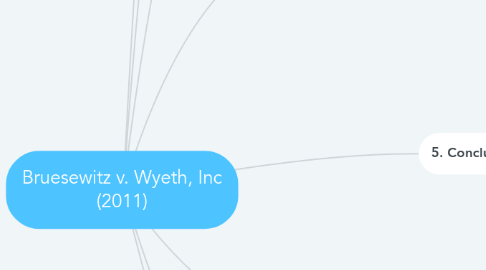
1. 1. Facts
1.1. Parties
1.1.1. Russell and Robalee Bruesewitz, Parents of Hannah. Plantiff
1.1.2. Wyeth Inc., Defendant
1.2. What Happened?
1.2.1. Hannah Bruesewitz, received Wyeth's "Tri-Immunol DTP" vaccine as part of her 6-month childhood immunizations in 1992.
1.2.2. Two hours after administration of the vaccine, she started developing seizures and was hospitalized for weeks. Hannah continued to have residual seizure disorder which required her to receive constant care.
1.2.3. Her parents claim that she developed seizures and disorder due to being administered the Wyeth vaccine
1.3. Procedural History
1.3.1. Bruesewitz family filed a petition seeking compensation for her injuries in 1995 within "Vaccine Court" of the US Court of Federal Claims.
1.3.1.1. Their petition was dismissed for failure to prove a link between the vaccine and Hannah's health problems
1.3.2. In 1998, Wyeth withdrew the "Tri-Immunol DTP" vaccine that Hannah received from the market.
1.3.3. The Bruesewitzes filed a lawsuit against Wyeth in state court in Pennsylvania.
1.3.3.1. The judge dismissed the lawsuit, ruling that the National Childhood Vaccine Injury Act of 1986 protected vaccine manufacturers from lawsuits over vaccine injury claims. The Third Circuit Court of Appeals affirmed this decision.
1.3.4. The Brusewitzes were not satisfied with the decision of a lower court and petitioned the U.S. Supreme Court to hear their case (writ of centiorari).
1.3.4.1. The petition for a writ of certiorari was granted in 2010, bringing the case to the Supreme Court
2. 2. Issues
2.1. Can the National Childhood Vaccine Injury Act of 1986 protect vaccine manufacturers from certain product liability lawsuits in state court that seek damages for serious health problems suffered by children?
3. 3. Rule of Law
3.1. National Childhood Vaccine Injury Act
3.1.1. Section 22(b)(1) of the NCVIA, protects manufacturers from civil liability of "unavoidable" vaccine related injuries or death
3.1.1.1. Excessive injury claims against vaccine would have driven the vaccine manufacturer's away from producing and designing new vaccines
3.1.2. Vaccine manufacturers are not liable for vaccine-induced injury or death if they are "accompanied by proper directions and warnings.
4. 4. Analysis/Application
4.1. Plaintiff
4.1.1. The Bruesewitzes argued that the vaccine, which was developed in the 1940s, hadn’t been updated since. They stated that other companies had updated their DTP vaccines. Therefore, the design defects of the Wyeth vaccine caused “avoidable” harm.
4.1.1.1. They argue that the company could have made an earlier update and didn’t for financial reasons
4.1.2. The Bruesewitzes agrued that Hannah’s injuries could have been avoided had Wyeth used an alternate design called ACEL-IMUNE (“DTaP”)
4.1.3. Bruesewitzes argue that the Vaccine Court established by the NCVIA does not provide vaccine victims with the same opportunity as a civil court to pursue a fair hearing of their grievances.
4.2. Defendant
4.2.1. Wyeth argues that the Bruesewitzes’ interpretation relies on an erroneous treatment of “unavoidable” as a freestanding term
4.2.2. Wyeth argues that Section 22(b)(1) aims to hold manufacturers liable for the defective manufacturing or labeling of a vaccine, acts which are solely within the manufacturers’ control, but not for the negligent design of a vaccine, an act which is outside the manufacturers’ control and heavily dependent on federal regulation.
4.3. Court
4.3.1. Congress had set up a special vaccine court as a way to provide compensation to injured children without driving drug manufacturers from the vaccine market. Justice Scalia argued that to allow civil litigation for vaccine injury claims that had failed in Vaccine Court would set a precedent that would destroy the market for vaccines.
4.3.1.1. Juries would be sympathetic to the situation of the parents, regardless of medical evidence, and litigation would go through the roof
5. 5. Conclusion
5.1. The supreme court affirmed the decision of the lower courts, ruling in favor of Wyeth Laboratories
5.2. Vaccine manufacturers are not liable for vaccine-induced injury or death if they are "accompanied by proper directions and warnings.
6. 6. Impact
6.1. The FDA had not approved DTaP until 1996, It would not have been available in 1992.
6.2. Holmes v. Merck & Co., Inc. (2012)
6.2.1. Jacob, 1 year old, received the MMR vaccine and developed seizures and encephalopathy within 9 days.
6.2.2. Manufacturer produced evidence that it had complied with all regulatory requirements related to the vaccine.
6.2.3. This case was used as precedent to show that there was no design defect and failure to warn.
6.3. Sebelius v. Cloer (2013)
6.3.1. Dr Cloer, Student, as vaccinated for Hepatitis B in 1996 and 1997. She reports have symptoms of Multiple Sclerosis a few days later.
6.3.2. Her claims were dismissed, but then she filed a petition for attorney fees and costs incurred in the appeal.
6.3.3. This case helped decide that the NCVIA Act states that as long as the petition was filed in good faith and a reasonable basis, the petitioner is eligible for an award of attorney's fees.
7. 7. Importance
7.1. Current pharmaceutical vaccine development and launch are influenced by protection from the National Childhood Vaccine Injury Act
7.2. If the Supreme Court had sided with the Bruesewitzes, there may have been a decline in vaccine use and supply. Numerous cases against vaccines manufactures resulting in little to no new vaccine developments for preventable diseases.
8. 8. Influence
8.1. Public Health Department
8.1.1. The case helped ensure there will not be a shortage of vaccine supply due to lawsuits. This is important for the good of general public.
8.1.2. I believe that if parents felt these vaccines were deemed "dangerous"for children, trhere would be a decrease in overall vaccine usage.
8.2. Vaccine Manufacters
8.2.1. Continued profitability to without excess litigation fees. Can dedicate time and money to production and development of new vaccines.
8.2.2. Demand remains. Again, if vaccines were considered "dangerous" due to the recurrent claims against the manufacturers, the demand for vaccines would tremendously decrease.
